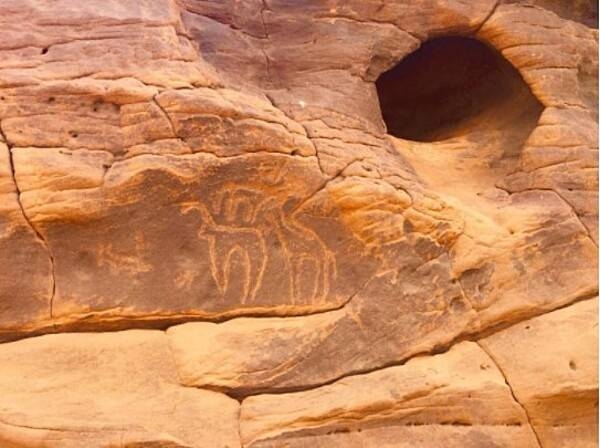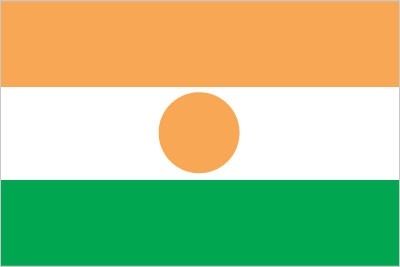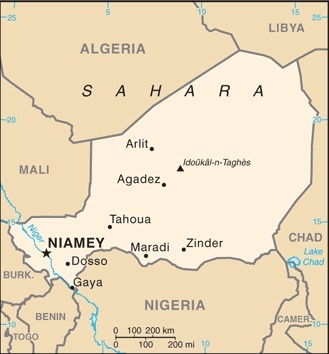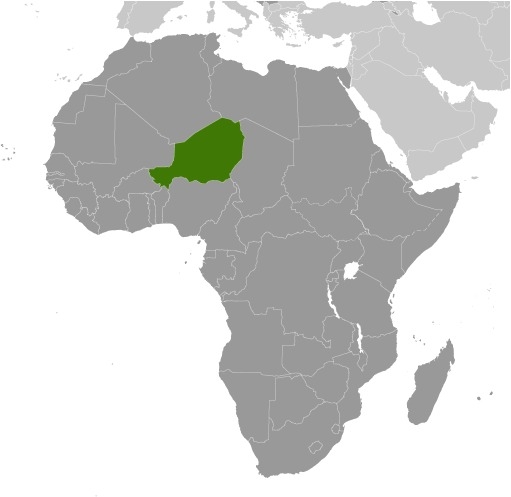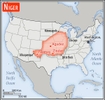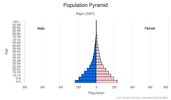Introduction
Background
Present-day Niger originated from the nomadic peoples of the Saharan north and the agriculturalists of the south. The Taureg kingdom of Takedda was one of the largest kingdoms in the north and played a prominent role in regional trade in the 14th century. In the south, the primary ethnic groups were the Songhai-Zarma in the west, the Hausa in the center, and the Kanuri in the east. When European colonizers arrived in the 19th century, the region was an assemblage of disparate local kingdoms.
In the late 19th century, the British and French agreed to partition the middle regions of the Niger River, and France began its conquest of what would become the colony of Niger. France experienced determined local resistance - particularly during the Tuareg uprising (1916-1917) - but established a colonial administration in 1922.
After achieving independence from France in 1960, Niger experienced single-party or military rule until 1991 when political pressure forced General Ali SAIBOU to allow multiparty elections. Political infighting and democratic backsliding led to coups in 1996 and 1999. In December of that year, military officers restored democratic rule and held elections that brought Mamadou TANDJA to power. TANDJA was reelected in 2004 and spearheaded a 2009 constitutional amendment allowing him to extend his presidential term. In February 2010, military officers led another coup that deposed TANDJA. ISSOUFOU Mahamadou was elected in April 2011 and reelected in early 2016. In February 2021, BAZOUM Mohammed won the presidential election, marking Niger’s first transition from one democratically elected president to another.
Niger is one of the poorest countries in the world with minimal government services and insufficient funds to develop its resource base. It is ranked last in the world on the UN Development Programme's Human Development Index. The largely agrarian and subsistence-based economy is frequently disrupted by extended droughts common to the Sahel region of Africa. The Nigerien Government continues its attempts to diversify the economy through increased oil production and mining projects. In addition, Niger is facing increased security concerns on its borders from various external threats including insecurity in Libya, spillover from the conflict and terrorism in Mali, and violent extremism in northeastern Nigeria.
Visit the Definitions and Notes page to view a description of each topic.
Geography
Location
Western Africa, southeast of Algeria
Geographic coordinates
16 00 N, 8 00 E
Map references
Africa
Area
total: 1.267 million sq km
land: 1,266,700 sq km
water: 300 sq km
Land boundaries
total: 5,834 km
border countries (7): Algeria 951 km, Benin 277 km, Burkina Faso 622 km, Chad 1196 km, Libya 342 km, Mali 838 km, Nigeria 1608 km
Coastline
0 km (landlocked)
Maritime claims
none (landlocked)
Climate
desert; mostly hot, dry, dusty; tropical in extreme south
Terrain
predominately desert plains and sand dunes; flat to rolling plains in south; hills in north
Elevation
highest point: Idoukal-n-Taghes 2,022 m
lowest point: Niger River 200 m
mean elevation: 474 m
Natural resources
uranium, coal, iron ore, tin, phosphates, gold, molybdenum, gypsum, salt, petroleum
Land use
agricultural land: 35.1% (2018 est.)
arable land: 12.3% (2018 est.)
permanent crops: 0.1% (2018 est.)
permanent pasture: 22.7% (2018 est.)
forest: 1% (2018 est.)
other: 63.9% (2018 est.)
Irrigated land
1,000 sq km (2012)
Major watersheds (area sq km)
Atlantic Ocean drainage: Niger (2,261,741 sq km)
Internal (endorheic basin) drainage: Lake Chad (2,497,738 sq km)
Major aquifers
Lake Chad Basin, Lullemeden-Irhazer Basin, Murzuk-Djado Basin
Major lakes (area sq km)
Fresh water lake(s): Lake Chad (endorheic lake shared with Chad, Nigeria, and Cameroon) - 10,360-25,900 sq km
note - area varies by season and year to year
Major rivers (by length in km)
Niger (shared with Guinea [s], Mali, Benin, and Nigeria [m]) - 4,200 km
note – [s] after country name indicates river source; [m] after country name indicates river mouth
Population distribution
majority of the populace is located in the southernmost extreme of the country along the border with Nigeria and Benin as shown in this population distribution map
Natural hazards
recurring droughts
Geography - note
landlocked; one of the hottest countries in the world; northern four-fifths is desert, southern one-fifth is savanna, suitable for livestock and limited agriculture
People and Society
Nationality
noun: Nigerien(s)
adjective: Nigerien
Ethnic groups
Hausa 53.1%, Zarma/Songhai 21.2%, Tuareg 11%, Fulani (Peuhl) 6.5%, Kanuri 5.9%, Gurma 0.8%, Arab 0.4%, Tubu 0.4%, other/unavailable 0.9% (2006 est.)
Languages
French (official), Hausa, Djerma
Religions
Muslim 99.3%, Christian 0.3%, animist 0.2%, none 0.1% (2012 est.)
Demographic profile
Niger has the highest total fertility rate (TFR) of any country in the world, averaging close to 7 children per woman in 2016. A slight decline in fertility over the last few decades has stalled. This leveling off of the high fertility rate is in large part a product of the continued desire for large families. In Niger, the TFR is lower than the desired fertility rate, which makes it unlikely that contraceptive use will increase. The high TFR sustains rapid population growth and a large youth population – almost 70% of the populace is under the age of 25. Gender inequality, including a lack of educational opportunities for women and early marriage and childbirth, also contributes to high population growth.
Because of large family sizes, children are inheriting smaller and smaller parcels of land. The dependence of most Nigeriens on subsistence farming on increasingly small landholdings, coupled with declining rainfall and the resultant shrinkage of arable land, are all preventing food production from keeping up with population growth.
For more than half a century, Niger's lack of economic development has led to steady net outmigration. In the 1960s, Nigeriens mainly migrated to coastal West African countries to work on a seasonal basis. Some headed to Libya and Algeria in the 1970s to work in the booming oil industry until its decline in the 1980s. Since the 1990s, the principal destinations for Nigerien labor migrants have been West African countries, especially Burkina Faso and Cote d’Ivoire, while emigration to Europe and North America has remained modest. During the same period, Niger’s desert trade route town Agadez became a hub for West African and other Sub-Saharan migrants crossing the Sahara to North Africa and sometimes onward to Europe.
More than 60,000 Malian refugees have fled to Niger since violence between Malian government troops and armed rebels began in early 2012. Ongoing attacks by the Boko Haram Islamist insurgency, dating to 2013 in northern Nigeria and February 2015 in southeastern Niger, have pushed tens of thousands of Nigerian refugees and Nigerien returnees across the border to Niger and to displace thousands of locals in Niger’s already impoverished Diffa region.
Age structure
0-14 years: 50.58% (male 5,805,102/female 5,713,815)
15-24 years: 19.99% (male 2,246,670/female 2,306,285)
25-54 years: 23.57% (male 2,582,123/female 2,784,464)
55-64 years: 3.17% (male 357,832/female 364,774)
65 years and over: 2.68% (male 293,430/female 317,866) (2020 est.)
Dependency ratios
total dependency ratio: 109.5
youth dependency ratio: 104.1
elderly dependency ratio: 5.4
potential support ratio: 18.4 (2020 est.)
Median age
total: 14.8 years
male: 14.5 years
female: 15.1 years (2020 est.)
Population distribution
majority of the populace is located in the southernmost extreme of the country along the border with Nigeria and Benin as shown in this population distribution map
Urbanization
urban population: 16.8% of total population (2021)
rate of urbanization: 4.72% annual rate of change (2020-25 est.)
Major urban areas - population
1.336 million NIAMEY (capital) (2021)
Sex ratio
at birth: 1.03 male(s)/female
0-14 years: 1.02 male(s)/female
15-24 years: 0.97 male(s)/female
25-54 years: 0.93 male(s)/female
55-64 years: 0.98 male(s)/female
65 years and over: 0.92 male(s)/female
total population: 0.98 male(s)/female (2020 est.)
Mother's mean age at first birth
20.4 years (2012 est.)
note: median age at first birth among women 25-49
Maternal mortality ratio
509 deaths/100,000 live births (2017 est.)
country comparison to the world: 20Infant mortality rate
total: 68.12 deaths/1,000 live births
male: 73.02 deaths/1,000 live births
female: 63.06 deaths/1,000 live births (2021 est.)
Life expectancy at birth
total population: 59.7 years
male: 58.19 years
female: 61.26 years (2021 est.)
Contraceptive prevalence rate
11% (2017/18)
Drinking water source
improved: urban: 95.7% of population
rural: 59.2% of population
total: 65.2% of population
unimproved: urban: 4.3% of population
rural: 40.8% of population
total: 34.8% of population (2017 est.)
Current Health Expenditure
7.3% (2018)
Physicians density
0.04 physicians/1,000 population (2016)
Hospital bed density
0.4 beds/1,000 population (2017)
Sanitation facility access
improved: urban: 76.6% of population
rural: 12.9% of population
total: 23.3% of population
unimproved: urban: 23.4% of population
rural: 87.1% of population
total: 76.7% of population (2017 est.)
Major infectious diseases
degree of risk: very high (2020)
food or waterborne diseases: bacterial and protozoal diarrhea, hepatitis A, and typhoid fever
vectorborne diseases: malaria and dengue fever
water contact diseases: schistosomiasis
animal contact diseases: rabies
respiratory diseases: meningococcal meningitis
Literacy
definition: age 15 and over can read and write
total population: 35.1%
male: 43.6%
female: 26.7% (2018)
School life expectancy (primary to tertiary education)
total: 6 years
male: 7 years
female: 6 years (2017)
Unemployment, youth ages 15-24
total: 16.6%
male: 16.1%
female: 17.5% (2017 est.)
Environment
Environment - current issues
overgrazing; soil erosion; deforestation; desertification; contaminated water; inadequate potable water; wildlife populations (such as elephant, hippopotamus, giraffe, and lion) threatened because of poaching and habitat destruction
Environment - international agreements
party to: Biodiversity, Climate Change, Climate Change-Kyoto Protocol, Climate Change-Paris Agreement, Comprehensive Nuclear Test Ban, Desertification, Endangered Species, Environmental Modification, Hazardous Wastes, Law of the Sea, Nuclear Test Ban, Ozone Layer Protection, Wetlands
signed, but not ratified: none of the selected agreements
Air pollutants
particulate matter emissions: 70.8 micrograms per cubic meter (2016 est.)
carbon dioxide emissions: 2.02 megatons (2016 est.)
methane emissions: 22.99 megatons (2020 est.)
Climate
desert; mostly hot, dry, dusty; tropical in extreme south
Land use
agricultural land: 35.1% (2018 est.)
arable land: 12.3% (2018 est.)
permanent crops: 0.1% (2018 est.)
permanent pasture: 22.7% (2018 est.)
forest: 1% (2018 est.)
other: 63.9% (2018 est.)
Urbanization
urban population: 16.8% of total population (2021)
rate of urbanization: 4.72% annual rate of change (2020-25 est.)
Revenue from forest resources
forest revenues: 4.41% of GDP (2018 est.)
country comparison to the world: 16Major infectious diseases
degree of risk: very high (2020)
food or waterborne diseases: bacterial and protozoal diarrhea, hepatitis A, and typhoid fever
vectorborne diseases: malaria and dengue fever
water contact diseases: schistosomiasis
animal contact diseases: rabies
respiratory diseases: meningococcal meningitis
Food insecurity
widespread lack of access: due to civil conflict - according to the latest analysis, about 2.3 million people are assessed to need humanitarian assistance in the June−August 2021 period due to the increase in security incidents which have resulted in widespread disruption of agricultural and marketing activities, diminishing livelihood opportunities for households (2021)
Waste and recycling
municipal solid waste generated annually: 1,865,646 tons (1993 est.)
municipal solid waste recycled annually: 74,626 tons (2005 est.)
percent of municipal solid waste recycled: 4% (2005 est.)
Major lakes (area sq km)
Fresh water lake(s): Lake Chad (endorheic lake shared with Chad, Nigeria, and Cameroon) - 10,360-25,900 sq km
note - area varies by season and year to year
Major rivers (by length in km)
Niger (shared with Guinea [s], Mali, Benin, and Nigeria [m]) - 4,200 km
note – [s] after country name indicates river source; [m] after country name indicates river mouth
Major watersheds (area sq km)
Atlantic Ocean drainage: Niger (2,261,741 sq km)
Internal (endorheic basin) drainage: Lake Chad (2,497,738 sq km)
Major aquifers
Lake Chad Basin, Lullemeden-Irhazer Basin, Murzuk-Djado Basin
Total water withdrawal
municipal: 178.9 million cubic meters (2017 est.)
industrial: 36 million cubic meters (2017 est.)
agricultural: 1.536 billion cubic meters (2017 est.)
Total renewable water resources
34.05 billion cubic meters (2017 est.)
Government
Country name
conventional long form: Republic of Niger
conventional short form: Niger
local long form: Republique du Niger
local short form: Niger
etymology: named for the Niger River that passes through the southwest of the country; from a native term "Ni Gir" meaning "River Gir"
note: pronounced nee-zher
Government type
semi-presidential republic
Capital
name: Niamey
geographic coordinates: 13 31 N, 2 07 E
time difference: UTC+1 (6 hours ahead of Washington, DC, during Standard Time)
etymology: according to tradition, the site was originally a fishing village named after a prominent local tree referred to as "nia niam"
Administrative divisions
7 regions (regions, singular - region) and 1 capital district* (communaute urbaine); Agadez, Diffa, Dosso, Maradi, Niamey*, Tahoua, Tillaberi, Zinder
Independence
3 August 1960 (from France)
National holiday
Republic Day, 18 December (1958); note - commemorates the founding of the Republic of Niger which predated independence from France in 1960
Constitution
history: several previous; passed by referendum 31 October 2010, entered into force 25 November 2010
amendments: proposed by the president of the republic or by the National Assembly; consideration of amendments requires at least three-fourths majority vote by the Assembly; passage requires at least four-fifths majority vote; if disapproved, the proposed amendment is dropped or submitted to a referendum; constitutional articles on the form of government, the multiparty system, the separation of state and religion, disqualification of Assembly members, amendment procedures, and amnesty of participants in the 2010 coup cannot be amended; amended 2011, 2017
Legal system
mixed legal system of civil law, based on French civil law, Islamic law, and customary law
International law organization participation
has not submitted an ICJ jurisdiction declaration; accepts ICCt jurisdiction
Citizenship
citizenship by birth: no
citizenship by descent only: at least one parent must be a citizen of Niger
dual citizenship recognized: yes
residency requirement for naturalization: unknown
Suffrage
18 years of age; universal
Executive branch
chief of state: President Mohamed BAZOUM (since 2 April 2021)
head of government: Prime Minister Ouhoumoudou MAHAMADOU (since 3 April 2021)
cabinet: Cabinet appointed by the president
elections/appointments: president directly elected by absolute majority popular vote in 2 rounds if needed for a 5-year term (eligible for a second term); election last held on 27 December 2020 with a runoff held on 21 February 2021, which BAZOUM won; prime minister appointed by the president, authorized by the National Assembly
election results: percent of vote in 2020 first round - Mohamed BAZOUM (PNDS-Tarrayya) 39.33%, Mahamane OUSMANE (MODEN/FA Lumana Africa) 17%, Seini OUMAROU (MNSD-Nassara) 8.95%, Albade ABOUDA (MPR-Jamhuriya) 7.07%; percent of vote in 2021 second round - Mohamed BAZOUM (PNDS-Tarrayya) 55.67%, Mahamane OUSMANE (RDR Tchanji) 44.33%
2016 results: ISSOUFOU Mahamadou reelected president in second round; percent of vote in first round - ISSOUFOU Mahamadou (PNDS-Tarrayya) 48.6%, Hama AMADOU (MODEN/FA Lumana Africa) 17.8%, Seini OUMAROU (MNSD-Nassara) 11.3%, other 22.3%; percent of vote in second round - ISSOUFOU Mahamadou 92%, Hama AMADOU 8%
Legislative branch
description: unicameral National Assembly or Assemblee Nationale (171 seats; 158 members directly elected from 8 multi-member constituencies in 7 regions and Niamey by party-list proportional representation, 8 reserved for minorities elected in special single-seat constituencies by simple majority vote, 5 seats reserved for Nigeriens living abroad - l seat per continent - elected in single-seat constituencies by simple majority vote; members serve 5-year terms)
elections: last held on 21 February 2016 (next to be held on 27 December 2020)
election results: percent of vote by party - PNDS-Tarrayya 44.1%, MODEN/FA Lumana 14.7%, MNSD-Nassara 11.8%, MPR-Jamhuriya 7.1%, MNRD Hankuri-PSDN Alheri 3.5%, MPN-Kishin Kassa 2.9%, ANDP-Zaman Lahiya 2.4%, RSD-Gaskiya 2.4%, CDS-Rahama 1.8%, CPR-Inganci 1.8%, RDP-Jama'a 1.8%, AMEN AMIN 1.8%, other 3.9%; seats by party - PNDS-Tarrayya 75, MODEN/FA Lumana 25, MNSD-Nassara 20, MPR-Jamhuriya 12, MNRD Hankuri-PSDN Alheri 6, MPN-Kishin Kassa 5, ANDP-Zaman Lahiya 4, RSD-Gaskiya 4, CDS-Rahama 3, CPR-Inganci 3, RDP-Jama'a 3, RDP-Jama'a 3, AMEN AMIN 3, other 8; composition - men 146, women 24 percent of women 14.6%
Judicial branch
highest courts: Constitutional Court (consists of 7 judges); High Court of Justice (consists of 7 members)
judge selection and term of office: Constitutional Court judges nominated/elected - 1 by the president of the Republic, 1 by the president of the National Assembly, 2 by peer judges, 2 by peer lawyers, 1 law professor by peers, and 1 from within Nigerien society; all appointed by the president; judges serve 6-year nonrenewable terms with one-third of membership renewed every 2 years; High Judicial Court members selected from among the legislature and judiciary; members serve 5-year terms
subordinate courts: Court of Cassation; Council of State; Court of Finances; various specialized tribunals and customary courts
Political parties and leaders
Alliance of Movements for the Emergence of Niger or AMEN AMIN [Omar Hamidou TCHIANA]
Congress for the Republic or CPR-Inganci [Kassoum MOCTAR]
Democratic Alliance for Niger or ADN-Fusaha [Habi Mahamadou SALISSOU]
Democratic and Social Convention-Rahama or CDS-Rahama [Abdou LABO]
National Movement for the Development of Society-Nassara or MNSD-Nassara [Seini OUMAROU]
Nigerien Alliance for Democracy and Progress-Zaman Lahiya or ANDP-Zaman Lahiya [Moussa Moumouni DJERMAKOYE]
Nigerien Democratic Movement for an African Federation or MODEN/FA Lumana [Hama AMADOU]
Nigerien Movement for Democratic Renewal or MNRD-Hankuri [Mahamane OUSMANE]
Nigerien Party for Democracy and Socialism or PNDS-Tarrayya [Mahamadou ISSOUFOU]
Nigerien Patriotic Movement or MPN-Kishin Kassa [Ibrahim YACOUBA]
Party for Socialism and Democracy in Niger or PSDN-Alheri
Patriotic Movement for the Republic or MPR-Jamhuriya [Albade ABOUBA]
Rally for Democracy and Progress-Jama'a or RDP-Jama'a [Hamid ALGABID]
Social and Democratic Rally or RSD-Gaskiyya [Amadou CHEIFFOU]
Social Democratic Party or PSD-Bassira [Mohamed BEN OMAR]
Union for Democracy and the Republic-Tabbat or UDR-Tabbat [Amadou Boubacar CISSE]
note: the SPLM and SPLM-DC are banned political parties
International organization participation
ACP, AfDB, AU, CD, ECOWAS, EITI (compliant country), Entente, FAO, FZ, G-77, IAEA, IBRD, ICAO, ICCt, ICRM, IDA, IDB, IFAD, IFC, IFRCS, ILO, IMF, Interpol, IOC, IOM, IPU, ISO (correspondent), ITSO, ITU, ITUC (NGOs), MIGA, MINUSMA, MONUSCO, NAM, OIC, OIF, OPCW, UN, UNCTAD, UNESCO, UNIDO, UNMIL, UNOCI, UNWTO, UPU, WADB (regional), WAEMU, WCO, WFTU (NGOs), WHO, WIPO, WMO, WTO
Diplomatic representation in the US
chief of mission: Ambassador (vacant); Charge d'Affaires Mahamane Bachir FIFI, Minister (since 16 December 2020)
chancery: 2204 R Street NW, Washington, DC 20008
telephone: [1] (202) 483-4224
FAX: [1] (202) 483-3169
email address and website:
communication@embassyofniger.org
http://www.embassyofniger.org/
Diplomatic representation from the US
chief of mission: Ambassador Eric P. WHITAKER (since 26 January 2018)
embassy: BP 11201, Niamey
mailing address: 2420 Niamey Place, Washington DC 20521-2420
telephone: [227] 20-72-26-61
FAX: [227] 20-73-55-60
email address and website:
consulateniamey@state.gov
https://ne.usembassy.gov/
Flag description
three equal horizontal bands of orange (top), white, and green with a small orange disk centered in the white band; the orange band denotes the drier northern regions of the Sahara; white stands for purity and innocence; green symbolizes hope and the fertile and productive southern and western areas, as well as the Niger River; the orange disc represents the sun and the sacrifices made by the people
note: similar to the flag of India, which has a blue spoked wheel centered in the white band
National symbol(s)
zebu; national colors: orange, white, green
National anthem
name: "La Nigerienne" (The Nigerien)
lyrics/music: Maurice Albert THIRIET/Robert JACQUET and Nicolas Abel Francois FRIONNET
note: adopted 1961
Economy
Economic overview
Niger is a landlocked, Sub-Saharan nation, whose economy centers on subsistence crops, livestock, and some of the world's largest uranium deposits. Agriculture contributes approximately 40% of GDP and provides livelihood for over 80% of the population. The UN ranked Niger as the second least developed country in the world in 2016 due to multiple factors such as food insecurity, lack of industry, high population growth, a weak educational sector, and few prospects for work outside of subsistence farming and herding.
Since 2011 public debt has increased due to efforts to scale-up public investment, particularly that related to infrastructure, as well as due to increased security spending. The government relies on foreign donor resources for a large portion of its fiscal budget. The economy in recent years has been hurt by terrorist activity near its uranium mines and by instability in Mali and in the Diffa region of the country; concerns about security have resulted in increased support from regional and international partners on defense. Low uranium prices, demographics, and security expenditures may continue to put pressure on the government’s finances.
The Government of Niger plans to exploit oil, gold, coal, and other mineral resources to sustain future growth. Although Niger has sizable reserves of oil, the prolonged drop in oil prices has reduced profitability. Food insecurity and drought remain perennial problems for Niger, and the government plans to invest more in irrigation. Niger’s three-year $131 million IMF Extended Credit Facility (ECF) agreement for the years 2012-15 was extended until the end of 2016. In February 2017, the IMF approved a new 3-year $134 million ECF. In June 2017, The World Bank’s International Development Association (IDA) granted Niger $1 billion over three years for IDA18, a program to boost the country’s development and alleviate poverty. A $437 million Millennium Challenge Account compact for Niger, commencing in FY18, will focus on large-scale irrigation infrastructure development and community-based, climate-resilient agriculture, while promoting sustainable increases in agricultural productivity and sales.
Formal private sector investment needed for economic diversification and growth remains a challenge, given the country’s limited domestic markets, access to credit, and competitiveness. Although President ISSOUFOU is courting foreign investors, including those from the US, as of April 2017, there were no US firms operating in Niger. In November 2017, the National Assembly passed the 2018 Finance Law that was geared towards raising government revenues and moving away from international support.
Real GDP (purchasing power parity)
$28.97 billion note: data are in 2017 dollars (2020 est.)
$28.54 billion note: data are in 2017 dollars (2019 est.)
$26.95 billion note: data are in 2017 dollars (2018 est.)
note: data are in 2017 dollars
Real GDP growth rate
4.9% (2017 est.)
4.9% (2016 est.)
4.3% (2015 est.)
Real GDP per capita
$1,200 note: data are in 2017 dollars (2020 est.)
$1,200 note: data are in 2017 dollars (2019 est.)
$1,200 note: data are in 2017 dollars (2018 est.)
note: data are in 2017 dollars
GDP (official exchange rate)
$12.926 billion (2019 est.)
Inflation rate (consumer prices)
-2.5% (2019 est.)
6.3% (2018 est.)
2.3% (2017 est.)
Credit ratings
Moody's rating: B3 (2019)
GDP - composition, by sector of origin
agriculture: 41.6% (2017 est.)
industry: 19.5% (2017 est.)
services: 38.7% (2017 est.)
GDP - composition, by end use
household consumption: 70.2% (2017 est.)
government consumption: 9.4% (2017 est.)
investment in fixed capital: 38.6% (2017 est.)
investment in inventories: 0% (2017 est.)
exports of goods and services: 16.4% (2017 est.)
imports of goods and services: -34.6% (2017 est.)
Agricultural products
millet, cow peas, sorghum, onions, milk, groundnuts, cassava, cabbages, goat milk, fruit
Industries
uranium mining, petroleum, cement, brick, soap, textiles, food processing, chemicals, slaughterhouses
Labor force - by occupation
agriculture: 79.2%
industry: 3.3%
services: 17.5% (2012 est.)
Population below poverty line
40.8% (2018 est.)
Gini Index coefficient - distribution of family income
34.3 (2014 est.)
50.5 (1995)
Household income or consumption by percentage share
lowest 10%: 3.2%
highest 10%: 26.8% (2014)
Budget
revenues: 1.757 billion (2017 est.)
expenditures: 2.171 billion (2017 est.)
Fiscal year
calendar year
Current account balance
-$1.16 billion (2017 est.)
-$1.181 billion (2016 est.)
Exports
$1.39 billion note: data are in current year dollars (2019 est.)
$1.45 billion note: data are in current year dollars (2018 est.)
Exports - partners
United Arab Emirates 54%, China 25%, France 7%, Pakistan 5% (2019)
Exports - commodities
gold, sesame seeds, uranium, natural gas, refined petroleum (2019)
Imports
$3.4 billion note: data are in current year dollars (2019 est.)
$3.37 billion note: data are in current year dollars (2018 est.)
Imports - partners
China 19%, France 9%, United Arab Emirates 7%, Cote d'Ivoire 6%, India 6%, Nigeria 5%, Togo 5%, Turkey 5% (2019)
Imports - commodities
rice, packaged medicines, palm oil, cars, cement (2019)
Reserves of foreign exchange and gold
$1.314 billion (31 December 2017 est.)
$1.186 billion (31 December 2016 est.)
Debt - external
$3.728 billion (31 December 2017 est.)
$2.926 billion (31 December 2016 est.)
Exchange rates
Communaute Financiere Africaine francs (XOF) per US dollar -
605.3 (2017 est.)
593.01 (2016 est.)
593.01 (2015 est.)
591.45 (2014 est.)
494.42 (2013 est.)
Unemployment, youth ages 15-24
total: 16.6%
male: 16.1%
female: 17.5% (2017 est.)
Energy
Electricity access
electrification - total population: 14% (2019)
electrification - urban areas: 71% (2019)
electrification - rural areas: 2% (2019)
Electricity - installed generating capacity
184,000 kW (2016 est.)
country comparison to the world: 168Electricity - from fossil fuels
95% of total installed capacity (2016 est.)
country comparison to the world: 45Electricity - from nuclear fuels
0% of total installed capacity (2017 est.)
country comparison to the world: 156Electricity - from hydroelectric plants
0% of total installed capacity (2017 est.)
country comparison to the world: 190Electricity - from other renewable sources
5% of total installed capacity (2017 est.)
country comparison to the world: 107Refined petroleum products - production
15,280 bbl/day (2015 est.)
country comparison to the world: 94Refined petroleum products - consumption
14,000 bbl/day (2016 est.)
country comparison to the world: 156Communications
Telephones - fixed lines
total subscriptions: 114,352 (2018)
subscriptions per 100 inhabitants: less than 1 (2018 est.)
Telephones - mobile cellular
total subscriptions: 8,778,880 (2018)
subscriptions per 100 inhabitants: 40.64 (2019 est.)
Telecommunication systems
general assessment: difficult economic climate, with lack of fixed telecom infrastructure; mobile services stronger than fixed telecom; low broadband penetration; adopted free mobile roaming with other G5 Sahel countries; World Bank project to facilitate digital progress; government contributes to Trans-Sahara Backbone network, with aims to extend fiber-optic and international capacity; LTE license awarded; government substantially taxes telecom sector (2020)
domestic: fixed-line 1 per 100 persons and mobile-cellular teledensity remains 41 per 100 persons despite a rapidly increasing cellular subscribership base; small system of wire, radio telephone communications, and microwave radio relay links concentrated in southwestern Niger; domestic satellite system with 3 earth stations and 1 planned (2019)
international: country code - 227; satellite earth stations - 2 Intelsat (1 Atlantic Ocean and 1 Indian Ocean)
note: the COVID-19 pandemic continues to have a significant impact on production and supply chains globally; since 2020, some aspects of the telecom sector have experienced downturn, particularly in mobile device production; many network operators delayed upgrades to infrastructure; progress towards 5G implementation was postponed or slowed in some countries; consumer spending on telecom services and devices was affected by large-scale job losses and the consequent restriction on disposable incomes; the crucial nature of telecom services as a tool for work and school from home became evident, and received some support from governments
Broadcast media
state-run TV station; 3 private TV stations provide a mix of local and foreign programming; state-run radio has only radio station with national coverage; about 30 private radio stations operate locally; as many as 100 community radio stations broadcast; transmissions of multiple international broadcasters are available
Internet users
total: 3.36 million (2021 est.)
percent of population: 10.22% (2019 est.)
Broadband - fixed subscriptions
total: 8,650 (2017 est.)
subscriptions per 100 inhabitants: less than 1 (2017 est.)
Transportation
National air transport system
number of registered air carriers: 2 (2020)
inventory of registered aircraft operated by air carriers: 3
Airports - with paved runways
total: 10
2,438 to 3,047 m: 3
1,524 to 2,437 m: 6
914 to 1,523 m: 1 (2017)
Airports - with unpaved runways
total: 20
1,524 to 2,437 m: 3
914 to 1,523 m: 15
under 914 m: 2 (2013)
Heliports
1 (2013)
Pipelines
464 km oil
Roadways
total: 18,949 km (2010)
paved: 3,912 km (2010)
unpaved: 15,037 km (2010)
Waterways
300 km (the Niger, the only major river, is navigable to Gaya between September and March) (2012)
country comparison to the world: 93Military and Security
Military and security forces
Nigerien Armed Forces (Forces Armees Nigeriennes, FAN): Army, Nigerien Air Force, Niger Gendarmerie (GN); Ministry of Interior, Public Security, Decentralization, and Customary and Religious Affairs: Niger National Guard (GNN; aka Republican Guard), National Police (includes the Directorate of Territorial Surveillance, which is charged with border management) (2021)
note - the Gendarmerie is subordinate to the Ministry of Defense and has primary responsibility for rural security; the National Guard is responsible for domestic security and the protection of high-level officials and government buildings
Military expenditures
2.1% of GDP (2020 est.)
1.8% of GDP (2019)
2.5% of GDP (2018)
2.5% of GDP (2017)
2.2% of GDP (2016)
Military and security service personnel strengths
information varies; approximately 10,000 active troops (est. 6,000 Army; 200 Air Force; 4,000 Gendarmerie); est. 3,000 National Guard (2021)
Military equipment inventories and acquisitions
the FAN's inventory consists of a wide variety of older weapons; since 2010, the FAN has received small amounts of mostly second-hand equipment and donations from China, France, South Africa, Sweden, Ukraine, and the US (2021)
Military deployments
870 Mali (MINUSMA) (Sep 2021)
note - Niger is part of a five-nation anti-jihadist task force known as the G5 Sahel Group, set up in 2014 with Burkina Faso, Chad, Mali, and Mauritania
Military service age and obligation
has conscription, although it is reportedly not always enforced; 18 is the legal minimum age for compulsory or voluntary military service; enlistees must be Nigerien citizens and unmarried; 2-year service term; women may serve in health care (2021)
Military - note
as of 2021, the FAN was conducting counterinsurgency and counter-terrorism operations against Islamic militants on two fronts; in the Diffa region, the Nigeria-based Boko Haram terrorist group has conducted dozens of attacks on security forces, army bases, and civilians; on Niger’s western border with Mali, the Islamic State-West Africa (ISWA) has conducted numerous attacks on security personnel; a series of ISWA attacks on FAN forces near the Malian border in December of 2019 and January of 2020 resulted in the deaths of more than 170 soldiers; terrorist attacks continued throughout 2020 and into 2021
Niger is part of a five-nation anti-jihadist task force known as the G5 Sahel Group, set up in 2014 with Burkina Faso, Mali, Mauritania, and Chad; it has committed 1,100 troops and 200 gendarmes to the force; in early 2020, G5 Sahel military chiefs of staff agreed to allow defense forces from each of the states to pursue terrorist fighters up to 100 km into neighboring countries; the G5 force is backed by the UN, US, and France; G5 troops periodically conduct joint operations with French forces deployed to the Sahel under Operation Barkhane
Niger also has about 1,000 troops committed to the Multinational Joint Task Force (MNJTF) against Boko Haram; national MNJTF troop contingents are deployed within their own country territories, although cross‐border operations are conducted periodically (2021)
Terrorism
Terrorist group(s)
Boko Haram; Islamic State of Iraq and ash-Sham in the Greater Sahara; Islamic State of Iraq and ash-Sham – West Africa; Jama'at Nusrat al-Islam wal-Muslimin; al-Mulathamun Battalion (al-Mourabitoun)
note: details about the history, aims, leadership, organization, areas of operation, tactics, targets, weapons, size, and sources of support of the group(s) appear(s) in Appendix-T
Transnational Issues
Disputes - international
Libya claims about 25,000 sq km in a currently dormant dispute in the Tommo region; location of Benin-Niger-Nigeria tripoint is unresolved; only Nigeria and Cameroon have heeded the Lake Chad Commission's admonition to ratify the delimitation treaty that also includes the Chad-Niger and Niger-Nigeria boundaries; the dispute with Burkina Faso was referred to the ICJ in 2010
Refugees and internally displaced persons
refugees (country of origin): 186,957 (Nigeria), 61,373 (Mali) (2021)
IDPs: 264,257 (includes the regions of Diffa, Tillaberi, and Tahoua; unknown how many of the 11,000 people displaced by clashes between government forces and the Tuareg militant group, Niger Movement for Justice, in 2007 are still displaced; inter-communal violence; Boko Haram attacks in southern Niger, 2015) (2021)
Illicit drugs
a transit point for illicit drugs narcotics trafficked through the Sahara; drugs from South America, particularly cocaine, heroin, cannabis products, and synthetic drugs, transit en route to European and Middle Eastern markets; synthetic opioid tramadol is shipped from Nigeria through Niger to other African countries; hashish from Morocco is trafficked to Libya, Egypt, Europe, and the Middle East; traffickers are formalized networks of Arab, Tuareg, and Toubou transportation groups
